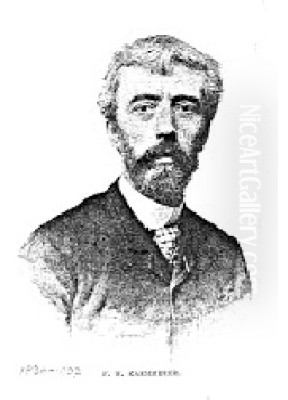
Frederik Hendrik Kaemmerer stands as a fascinating figure in late 19th-century European art. Born in the Netherlands, he navigated the shifting artistic currents of his time, moving from the atmospheric landscapes of the Hague School to the polished academicism of Paris, and later embracing the lighter touch of Impressionism. His work, particularly his elegant depictions of 18th-century French society, found immense popularity during his lifetime, securing him a place in prestigious collections and exhibitions. This exploration delves into the life, artistic evolution, and legacy of a painter who successfully bridged Dutch artistic sensibilities with the vibrant, competitive art world of Paris.
Early Life and Artistic Formation in The Hague
Frederik Hendrik Kaemmerer was born in The Hague, Netherlands, on October 23, 1839. His initial artistic training took place in his hometown at the prestigious Royal Academy of Art. Here, he studied under Salomon Leonardus Verveer, a prominent painter associated with the Dutch Romantic tradition. Verveer was known for his lively landscapes and townscapes, often imbued with a picturesque and anecdotal quality. Under Verveer's guidance, Kaemmerer initially focused on landscape painting, developing a style that aligned with the prevailing tastes in the Netherlands at the time.
His early work showed an affinity for the Hague School, a movement that emerged around the 1860s and 1870s. Artists of the Hague School, such as Jozef Israëls, Jacob Maris, Anton Mauve, Hendrik Willem Mesdag, and Willem Roelofs, were known for their realistic and often somber depictions of Dutch landscapes, peasant life, and coastal scenes. They were heavily influenced by the French Barbizon School painters like Jean-Baptiste-Camille Corot and Jean-François Millet, emphasizing mood, atmosphere, and the effects of light, often rendered in tonal palettes. Kaemmerer's early landscapes reflected this interest in capturing the specific atmosphere and character of the Dutch environment.
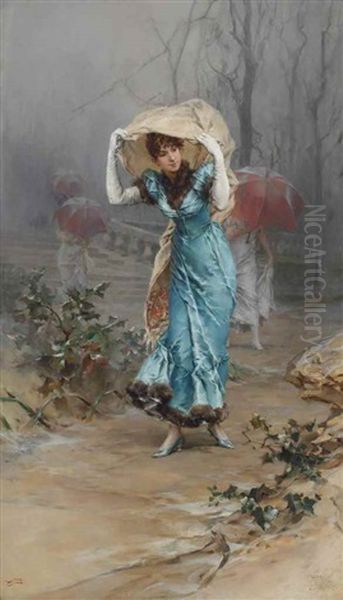
However, even in these formative years, Kaemmerer seemed destined for a different path than many of his Hague School contemporaries. While they often focused on the rustic and the everyday, Kaemmerer would eventually gravitate towards more elegant and historically evocative subjects. His training under Verveer provided a solid foundation in technique, but the artistic allure of Paris, the undisputed center of the art world in the 19th century, beckoned.
The Parisian Transformation: Academic Training and New Directions
In 1865, seeking broader horizons and advanced training, Kaemmerer made the pivotal decision to move to Paris. This move marked a significant turning point in his artistic development. He enrolled in the Académie des Beaux-Arts, entering the studio of Jean-Léon Gérôme. Gérôme was one of the most influential academic painters of his time, renowned for his highly detailed historical scenes, Orientalist subjects, and mastery of classical form and composition. Studying under Gérôme exposed Kaemmerer to the rigorous discipline and polished finish characteristic of French Academic art.
This Parisian training led Kaemmerer to shift his focus away from the Dutch landscapes that had characterized his early work. He began concentrating on figure painting and historical genre scenes, adopting a more refined and technically meticulous approach. The influence of Gérôme encouraged a precision in drawing, a smoothness of finish, and an emphasis on narrative clarity that contrasted sharply with the looser, more atmospheric style of the Hague School.
Kaemmerer made his debut at the prestigious Paris Salon in 1869 (some sources state 1870). His early submissions included works inspired by classical themes, possibly reflecting Gérôme's influence and the academic emphasis on historical and mythological subjects. These initial Salon appearances were met with positive reception, praising his skillful execution and handling of traditional themes, signaling his successful integration into the competitive Parisian art scene. This marked the beginning of a long and successful career exhibiting in France.
Rise to Fame: Mastering the Elegant Genre Scene
While his initial Salon entries drew on classical inspiration, Kaemmerer soon found his true calling and achieved widespread fame with a different type of subject matter: elegant genre scenes set in 18th-century France, particularly during the Directoire period (1795-1799). This era, following the Reign of Terror, was known for its distinctive fashion, social exuberance, and a revival of classical aesthetics in dress and manners. Kaemmerer excelled at capturing the grace, fashion, and social interactions of this period.
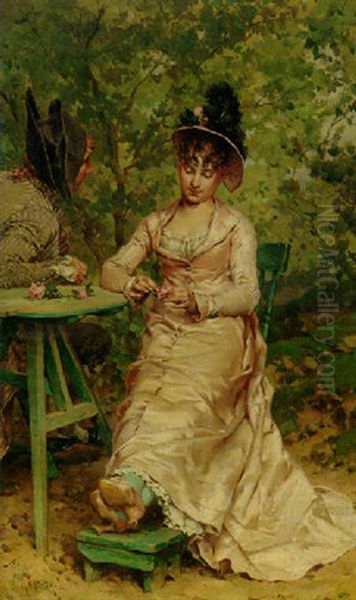
His paintings often depicted sophisticated ladies and gentlemen in luxurious interiors or picturesque outdoor settings, engaged in conversations, strolls, or social rituals. He paid meticulous attention to the details of costume – the high waistlines, flowing fabrics, elaborate hats, and powdered wigs – bringing the fashions of the late 18th century vividly to life. His figures were rendered with elegance and charm, capturing the refined gestures and social nuances of the era. This style, sometimes referred to as "French genre" or Rococo revival, proved immensely popular with collectors and critics in both France and the Netherlands.
One of his most celebrated works in this vein is Wedding Under the Directory (also known as Un Mariage sous le Directoire or Merveilles sous le Directoire). This painting exemplifies his skill in composing complex multi-figure scenes, his delicate rendering of fabrics and textures, and his ability to evoke a sense of historical atmosphere and social narrative. Another key work is Masquerade Ball (Baile de Máscaras), which showcases his talent for depicting lively social gatherings filled with elegantly costumed figures. These works cemented his reputation as a master of the historical genre scene.
His success was recognized with official accolades. At the Paris Salon of 1874, Kaemmerer was awarded a medal (often cited as a silver or first-class medal) for his contributions, a significant honor that confirmed his standing in the Parisian art establishment. He continued to exhibit regularly at the Salon, consistently presenting works that appealed to the public's taste for elegance and historical charm. His popularity extended beyond France; his paintings were sought after internationally.
Kaemmerer and the Art Market: Goupil & Cie and International Success
Kaemmerer's commercial success was significantly boosted by his association with the influential Parisian art dealership Goupil & Cie. Founded by Adolphe Goupil, and later managed by figures like Léon Boussod and René Valadon (with whom Theo van Gogh, Vincent's brother, worked), Goupil & Cie was a major force in the 19th-century art market. The gallery specialized in high-quality reproductions (engravings and photographs) as well as original works by popular contemporary artists, including academic masters like Jean-Léon Gérôme and William-Adolphe Bouguereau, as well as artists working in more modern styles.
Becoming a client of Goupil & Cie provided Kaemmerer with access to a vast network of collectors across Europe and America. The gallery actively promoted his work, ensuring its visibility and desirability. This relationship was mutually beneficial; Kaemmerer's polished and appealing genre scenes fit well within Goupil's portfolio of commercially successful art. The gallery's marketing prowess helped solidify Kaemmerer's international reputation and financial success. An example of his international reach is the purchase of Merveilles sous le Directoire by the American merchant Emil Brandenburg.
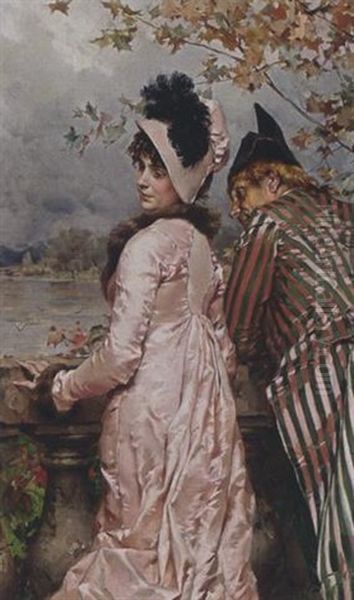
Beyond gallery sales, Kaemmerer also engaged in illustration work. He contributed illustrations to the Belgian illustrated magazine Elsevier's Geïllustreerd Maandschrift, demonstrating his versatility and his engagement with popular media of the time. This work further broadened his audience and showcased his narrative and descriptive skills in a different format. His ability to cater to market demands while maintaining a high level of technical skill was a key factor in his sustained success.
Embracing Impressionism: A Later Stylistic Shift
While Kaemmerer built his reputation on meticulously rendered historical genre scenes, his artistic journey did not end there. In his later career, he began to incorporate elements of Impressionism into his work. Living and working in Paris during the rise of Impressionism, he would have been well aware of the revolutionary changes being pioneered by artists like Claude Monet, Edgar Degas, and Pierre-Auguste Renoir. Though he never fully abandoned his academic foundations, Kaemmerer adapted his style to explore the effects of light and atmosphere in a manner influenced by the Impressionists.
This later phase saw him producing works with a brighter palette, looser brushwork, and a greater emphasis on capturing fleeting moments and the play of natural light. He often turned to contemporary scenes, particularly beach scenes and landscapes, often painted during his visits back to the Netherlands, especially the seaside resort of Scheveningen near The Hague. Works like Taking Cover from the Storm and The Red Umbrella exemplify this shift, showcasing a more spontaneous technique and a focus on atmospheric effects rather than intricate detail.
This evolution demonstrates Kaemmerer's adaptability and his willingness to engage with contemporary artistic developments. While his core audience likely still favored his elegant 18th-century scenes, his Impressionist-influenced works show an artist exploring new ways of seeing and representing the world around him. He managed to navigate between the established tastes catered to by the Salon and Goupil, and the newer trends emerging in the Parisian avant-garde, creating a diverse body of work that reflected the complex artistic landscape of the late 19th century. His success in this later style was also recognized, further solidifying his reputation as a versatile and accomplished painter. He received another significant award, a silver medal, at the Exposition Universelle (World's Fair) in Paris in 1889.
Connections and Contemporaries: Navigating the Art World
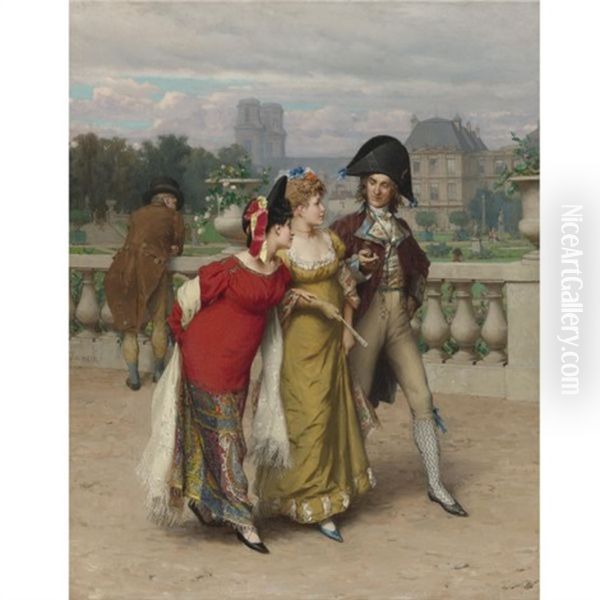
Throughout his career, Kaemmerer maintained connections with artists from both his native Netherlands and his adopted home in France. His initial training placed him firmly within the context of Dutch Romanticism and the Hague School, alongside his teacher Salomon Verveer and contemporaries like the Maris brothers (Jacob, Matthijs, and Willem) and Anton Mauve. He maintained a particularly close friendship with Jacob Maris, a leading figure of the Hague School. Maris even painted a portrait of Kaemmerer, attesting to their bond. Kaemmerer's regular return trips to the Netherlands, often staying at hotels in Scheveningen, allowed him to maintain these personal and professional ties.
In Paris, his most significant connection was undoubtedly his teacher, Jean-Léon Gérôme. Studying in Gérôme's atelier placed him within the mainstream of French Academic painting, alongside other students and established figures like William-Adolphe Bouguereau and Alexandre Cabanel, who dominated the official Salon. His association with Goupil & Cie also connected him commercially to a wide network of artists whose works the gallery represented.
While primarily known for his academic and later Impressionist-influenced styles, his work sometimes invites comparison with other painters of modern life and elegant society, such as the Frenchman Jean Béraud or the expatriate James Tissot, although Kaemmerer's focus remained largely on historical settings rather than contemporary Parisian chic. He also had students, such as Auguste Emile Pinchart, indicating his role in transmitting artistic knowledge. His career intersected with the Impressionists, though he was not part of their core group; his later work shows their influence rather than direct participation in their exhibitions or circles. His unique position allowed him to draw from various artistic streams – Dutch realism, French academicism, and Impressionism.
Personal Life, Views, and Final Years
Despite his considerable success and integration into the Parisian art world, Kaemmerer maintained strong ties to his Dutch roots. He frequently returned to The Hague, spending holidays by the sea, likely finding inspiration for his later beach scenes and maintaining contact with his Dutch friends and colleagues like Jacob Maris. He established his own studio in Paris, solidifying his presence in the city that had become central to his career.
Interestingly, surviving letters reveal a critical perspective on his adopted city. Despite thriving professionally in Paris, Kaemmerer expressed dissatisfaction with the city's sanitation, criticizing its dirtiness and lack of hygiene in his correspondence. This offers a glimpse into the personal experiences and perhaps the cultural adjustments of a Dutch artist living in the bustling, and at times gritty, metropolis of late 19th-century Paris.
His career, marked by significant achievements and international recognition, unfortunately ended tragically. Frederik Hendrik Kaemmerer died on April 4, 1902, at the age of 62. He took his own life in his Paris apartment. The reasons behind his suicide are not clearly documented, but his death brought an abrupt end to a prolific and successful artistic journey that had spanned several decades and stylistic transformations.
Legacy and Collections
Frederik Hendrik Kaemmerer left behind a substantial body of work that reflects the diverse artistic currents of his time. He is best remembered for his highly polished and charming depictions of 18th-century French life, which captured the imagination of the public and critics during his lifetime and remain appealing for their elegance and technical skill. His ability to adapt, moving from the Hague School's atmospheric realism to Parisian academic precision, and later incorporating Impressionist techniques, marks him as a versatile and responsive artist.
His work contributed significantly to the popularity of historical genre painting in the late 19th century. Furthermore, his success in Paris, facilitated by Goupil & Cie, served as an example for other Dutch artists seeking international careers, demonstrating how to navigate the competitive Parisian art market while depicting subjects – like fashionable scenes – that resonated with contemporary tastes. He showed that an artist could blend Dutch training with French sophistication to achieve widespread acclaim.
Today, Kaemmerer's paintings are held in various public and private collections worldwide. Notable institutions include the Metropolitan Museum of Art in New York. His works also appear periodically at major auction houses like Sotheby's in London, indicating continued interest among collectors. While perhaps not as revolutionary as some of his avant-garde contemporaries, Kaemmerer's art offers a valuable window into the tastes and artistic practices of the late 19th century, showcasing a masterful blend of technical proficiency, historical evocation, and stylistic adaptability.
Conclusion
Frederik Hendrik Kaemmerer's artistic journey from The Hague to Paris encapsulates the dynamic interplay between national traditions and international trends in 19th-century European art. He successfully transitioned from Dutch Romanticism and the Hague School's focus on landscape and atmosphere to the demanding standards of French Academicism under Jean-Léon Gérôme. His subsequent specialization in elegant 18th-century genre scenes brought him fame and fortune, making him a favorite of the Salon and the influential Goupil gallery. His later engagement with Impressionism further demonstrated his artistic flexibility. Though his life ended tragically, Kaemmerer's legacy endures through his finely crafted paintings, which continue to charm viewers with their elegance, detail, and skillful negotiation between artistic tradition and emerging modernity. He remains a significant figure, representing the successful adaptation of a Dutch painter to the vibrant, demanding, and ultimately rewarding art world of Paris.